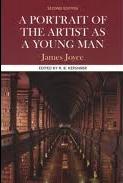‘Aesthetic Autobiography’ -- Satisfactory Description of the Genre of James Joyce's "A Portrait of the Artist as a Young"
A Portrait of the Artist as a Young Man is a semi-autobiographical novel about the education of a young Irishman, Stephen Daedalus, whose background has much in common with Joyce’s. However, in determining the genre of A Portrait readers and critics both face a lengthy debate. In terms of its critical reception A Portrait has had its share of detractors and its admirers. As far as its autobiographical elements are concerned A Portrait can be seen both as a ‘Bildungsroman’ which describes the youthful development of the central character and as ‘aesthetic autobiography’ or ‘kunstlerroman’. We will now carryout our discussions on Joyce’s portrayal of Stephen and see how he keeps varying his distance from Stephen but never does so drastically.
If Lawrence’s personal experiences have shaped the material in Sons and Lovers or if we find several facts of the life of Somerset Maugham with little modification or distortion in Of Human Bondage, the same approach to Joyce A Portrait cannot be reached. The characters in sons and lovers or Of Human Bondage seem to enjoy an independent existence; in A Portrait they figure mainly in the hero’s reveries and resentments. And the question if Joyce stations himself in relation to his hero Stephen is a crucial one. Alike Austen in her Emma both attempts at objectivity and subjectivity; Joyce’s A Portrait maintains the same status. Sometimes the two personae, Joyce and Stephen almost merge but quite often a distance is kept though it is never too great. This kind of management of distance allows Joyce to bring irony also in play at places but even that is never allowed to become too hard-hitting.
Except for the thin incognito of its characters, A Portrait of The Artist As a Young Man is based on a literal transcript of the first twenty years of Joyce’s life. If anything, it is more candid than other autobiographies. It is distinguished from them by its emphasis on the emotional and intellectual adventures of its protagonist. Joyce’s own life had a direct bearing on A Portrait. Literally A Portrait of the Artist as a Young Man covers the childhood and adolescence of Stephen Dedalus. We see him, over the course of the novel, grow from a little boy to a young man of eighteen who has decided to leave his country for Europe, in order to be an artist. This especially the case with how he reacted to Ireland and to Ireland’s treatment of Parnell. As we read the opening section the novel we can easily identify how the ‘betrayal’ of Parnell was a part of the Irish psyche of those time. The Parnell and the Irish situation in general have a direct bearing on the Christmas dinner scene. Again Joyce had a firm belief that the political subjection had led the Irish people to have a slavish mentality. Joyce had an attitude of deep distrust towards the Irish political activities and it is obvious in the closing sections of A Portrait. On the exchanges between students in the closing stages of the novel Stephen says to Davin with odd violence:
“Do you know what Ireland is? … Ireland is the old saw that eats her furrow”.
Further there are other aspects of Joyce’s life that find more or less a direct echo in the novel. Alike Joyce Stephen too shares a large family. The family’s poverty and its frequent changes of house both happen in Joyce and Stephen.
But despite of these similarities, A Portrait is not straight autobiography. Joyce was not the weak in health who figures in the novel. Joyce has drawn it true very largely upon his life and his own experience, but it is not an autobiography, it is an artistic creation. It is reshaped for artistic module. In a sense one can say that in offering us the growth and the development of Stephen Daedalus, Joyce was not exclusively concerned with getting to the heart of his own young self or an imaginary equivalent of that, but in getting to the heart of young artist as such. The destiny we are brought face to face with could be any young man’s destiny in Catholic Ireland. Especially, if the young man was sensitive and had artistic ambitions or pretensions.
We may again deal with another controversial issue – its title. As the phrase ‘Portrait of the Artists’ hints at the self-portraiture of Joyce, the other phrase ‘as a young man’ hints at it universal aspects or generalization. Stephen is young Joyce, “purified in and projected from the human imagination’ of the developed artist who must, in the words of Stephen, “try slowly and humbly and constantly to express, to press out again, from the gross earth or what it brings forth, from sound and shape and colour which are the prison gates of our soul, an image of the beauty we have come to understand”.
Thus Joyce uses his personal life as a framework for his novel but is free to revise his biography for artistic purposes or remodeled it, which can assert the growth of ‘artist’.
What happens in A Portrait is that the autobiographical element, which is otherwise its very significant ingredient, is consciously and painstakingly recast into a mode of depersonalization, objectification and presentation of a myth of an artist borne.


Comments
Post a Comment
Drop any query, suggestion or comment here.